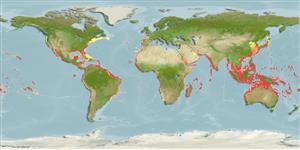>
Carangiformes (Jacks) >
Carangidae (Jacks and pompanos) > Caranginae
Etymology: Selar: A Malay vernacular name, ikan selar.
More on author: Bloch.
Environment: milieu / Zona climática / intervalo de profundidade / distribution range
Ecologia
marinhas associadas(os) a recifes; intervalo de profundidade 0 - 170 m (Ref. 9283), usually 2 - 10 m (Ref. 40849). Subtropical; 47°N - 31°S, 180°W - 180°E
Circumtropical. Indo-Pacific: East Africa (Ref. 3287) to Rapa, north to southern Japan and the Hawaiian Islands, south to New Caledonia. Eastern Pacific: Mexico to Peru, including the Galapagos Islands (Ref. 5530). Western Atlantic: Nova Scotia, Canada and Bermuda through the Gulf of Mexico and the Caribbean to to São Paulo (Ref. 47377), Brazil. Eastern Atlantic: Cape Verde to southern Angola (Ref. 7097).
Comprimento de primeira maturação / Tamanho / Peso / Idade
Maturidade: Lm 17.7 range ? - ? cm
Max length : 70.0 cm TL macho/indeterminado; (Ref. 48635); idade máx. registrada: 3.00 anos (Ref. 104735)
Espinhos dorsais (total) : 9; Raios dorsais (total) : 24 - 27; Espinhos anais: 3; Raios anais : 21 - 23.
Body shape (shape guide): fusiform / normal; Cross section: compressed.
Adults prefer clear oceanic waters around islands to neritic waters (Ref. 5217). Occasionally in turbid waters (Ref. 9283). Pelagic (Ref. 58302). Individuals travel in compact groups of hundreds of thousands of fish. Mainly nocturnal in habit, they disperse at night to feed on small shrimps, benthic invertebrates, and forams when inshore, and zooplankton and fish larvae when offshore (Ref. 9283, 90102). Marketed fresh and salted or dried (Ref. 9283). Reported to reach 70 cm TL (Ref. 48635).
Smith-Vaniz, W.F., 1995. Carangidae. Jureles, pámpanos, cojinúas, zapateros, cocineros, casabes, macarelas, chicharros, jorobados, medregales, pez pilota. p. 940-986. In W. Fischer, F. Krupp, W. Schneider, C. Sommer, K.E. Carpenter and V. Niem (eds.) Guia FAO para Identification de Especies para lo Fines de la Pesca. Pacifico Centro-Oriental. 3 Vols. FAO, Rome. (Ref. 9283)
Status na Lista Vermelha da UICN (Ref. 130435: Version 2025-1)
Ameaça para os humanos
Reports of ciguatera poisoning (Ref. 30911)
Uso pelos humanos
Pescarias: altamente comercial; peixe esportivo: sim; isca: usually
Ferramentas
Relatórios especiais
Baixar XML
Fontes da internet
Estimates based on models
Preferred temperature (Ref.
123201): 20 - 29.2, mean 27.9 °C (based on 6848 cells).
Índice de diversidade filogenética (Ref.
82804): PD
50 = 0.7500 [Uniqueness, from 0.5 = low to 2.0 = high].
Bayesian length-weight: a=0.01349 (0.01211 - 0.01503), b=2.99 (2.96 - 3.02), in cm total length, based on LWR estimates for this species (Ref.
93245).
Nível Trófico (Ref.
69278): 3.8 ±0.2 se; based on diet studies.
Generation time: 1.0 ( na - na) years. Estimated as median ln(3)/K based on 1
growth studies.
Resiliência (Ref.
120179): Elevada, tempo mínimo de duplicação da população menor que 15 meses (K=0.6-0.9).
Prior r = 1.19, 95% CL = 0.79 - 1.79, Based on 8 data-limited stock assessments.
Fishing Vulnerability (Ref.
59153): Low vulnerability (25 of 100).
🛈
Climate Vulnerability (Ref.
125649): High vulnerability (60 of 100).
🛈
Nutrients (Ref.
124155): Calcium = 44.7 [14.5, 96.7] mg/100g; Iron = 0.976 [0.355, 2.254] mg/100g; Protein = 21.2 [19.1, 23.1] %; Omega3 = 0.331 [0.165, 0.686] g/100g; Selenium = 51.7 [18.8, 141.0] μg/100g; VitaminA = 15.1 [3.9, 70.2] μg/100g; Zinc = 0.678 [0.337, 1.145] mg/100g (wet weight); based on
nutrient studies.
